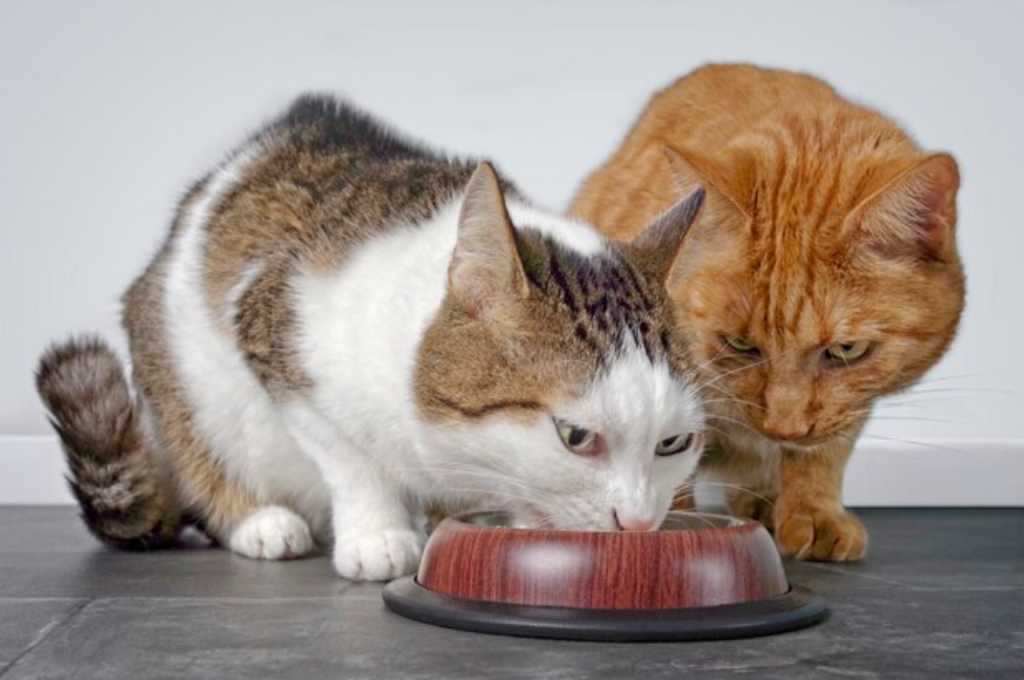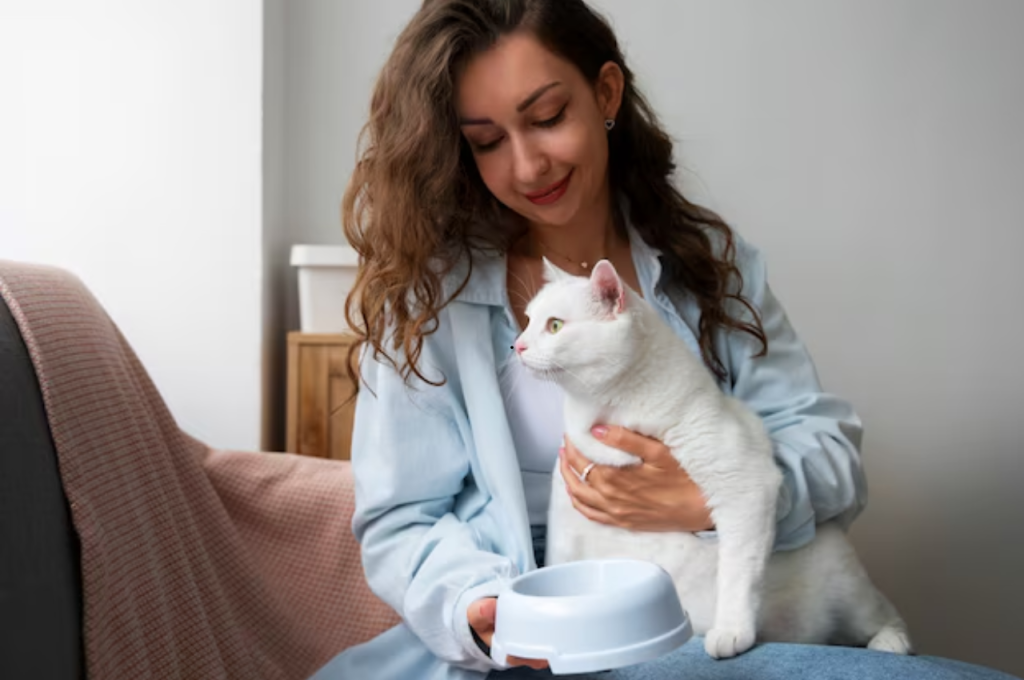To feed two cats with different eating habits, consider feeding them in separate areas and at the same time. Introducing slow feeders or puzzle feeders can also help regulate their eating pace and prevent food competition.
This can reduce stress and ensure both cats get the nutrients they need. When managing different eating habits, it’s important to monitor their individual intake and consult a veterinarian for personalized advice. Additionally, providing plenty of fresh water and feeding high-quality, balanced diets can support their overall health and well-being. By understanding and accommodating their unique eating preferences, you can help both cats thrive and maintain a harmonious feeding routine.
Identifying Unique Feline Eating Habits
Understanding your cats’ individual eating habits is crucial for maintaining their health and happiness. By spotting the differences and understanding individual needs, you can ensure both feline friends are well-fed.

Spotting The Differences
Observing your cats’ eating behaviors can reveal a lot about their preferences. Look for clues such as pace of eating, food preferences, and reaction to mealtime routines.
Understanding Individual Needs
Each cat is unique, with specific dietary requirements. Consider factors like age, activity level, and digestive sensitivities when planning their meals.
The Importance of Separate Feeding Spaces
Feeding two cats with different eating habits can be a challenging task. One cat may be a slow, picky eater, while the other may gobble up their food in seconds. This can lead to stress, food aggression, and ultimately, an unhealthy dining environment. One effective way to manage this is by providing separate feeding spaces for each cat.
Creating a Peaceful Dining Environment
Creating a peaceful dining environment is crucial for cats with different eating habits. By having separate feeding areas, each cat can eat at their own pace without feeling rushed or threatened by the other cat. This can reduce stress and promote a more harmonious mealtime experience for both cats.
Preventing Food Aggression
Separate feeding spaces help prevent food aggression between cats. When cats feel that their food source is threatened, they may exhibit aggressive behavior towards the other cat. By providing distinct feeding areas, each cat can feel secure and relaxed during mealtime, minimizing the likelihood of food-related conflicts.
Choosing The Right Food for Each Cat
When it comes to feeding two cats with different eating habits, selecting the appropriate food for each feline is crucial. Cats have varying nutritional requirements, and it’s essential to ensure that both cats receive the necessary nutrients.
Balancing Nutritional Needs
Understanding the nutritional needs of each cat is the first step. Consult with your veterinarian to determine the ideal diet for each feline based on factors like age, weight, and any existing health conditions.
Exploring Various Diet Options
- Consider different types of cat food such as dry kibble, wet food, or a combination of both.
- Rotate between flavors and textures to cater to the preferences of each cat.
- Introduce specialized diets if one cat has specific dietary requirements, such as weight management or digestive sensitivities.
Scheduling Meals Effectively
Efficiently scheduling meals for two cats with different eating habits can be a challenge. By creating a routine and using separate feeding areas, you can ensure each cat gets the right amount of food without any fuss.

Coordinating Feeding Times
When you have two cats with different eating habits, coordinating their feeding times can be a challenge. However, by scheduling meals effectively, you can ensure that both cats get the nourishment they need without any conflicts.
Adjusting to Each Cat’s Pace
One important aspect of scheduling meals effectively is adjusting to each cat’s pace. Some cats may eat quickly, while others may take their time. To accommodate both cats, you can try the following strategies:
- Separate the cats during mealtime: If one cat tends to eat quickly and finish their meal before the other cat starts, consider feeding them in separate areas. This will allow each cat to eat at their own pace without feeling rushed.
- Use puzzle feeders or slow-feed bowls: For the cat that eats too quickly, using puzzle feeders or slow-feed bowls can help slow down their eating process. These specialized feeding tools make the cat work for their food, promoting slower eating and reducing the likelihood of indigestion or vomiting.
- Monitor feeding times: Keep an eye on each cat’s feeding times and habits. If one cat consistently finishes their meal much faster or slower than the other cat, you may need to adjust their portion sizes accordingly. This will ensure that both cats are satisfied and receive the appropriate amount of food.
By taking these steps to adjust to each cat’s pace, you can create a more harmonious mealtime experience for both cats.
Using Technology to Simplify Feeding
Simplify feeding your two cats with different eating habits by using technology. With automatic feeders and portion control, you can ensure that each cat receives the right amount of food at the right time, without any fuss or stress.
Feeding two cats with different eating habits can be a challenging task. It’s not always easy to ensure that each cat is getting the right amount of food at the right time. However, using technology can make this task easier and less time-consuming. In this blog post, we will discuss how you can use technology to simplify feeding your cats.
Automated Feeders
One of the best ways to ensure that your cats are getting the right amount of food at the right time is to use automated feeders. These devices are designed to dispense a specific amount of food at a pre-determined time. This means that you can set the feeder to dispense food for one cat while the other cat is eating. This will ensure that each cat is getting the right amount of food at the right time.
Apps for Feeding Schedules
Another way to simplify feeding your cats is to use apps for feeding schedules. These apps allow you to set a feeding schedule for each cat. You can set the time and the amount of food that each cat should receive. Some apps also allow you to track your cat’s eating habits and send you reminders when it’s time to feed them. This is a great way to ensure that each cat is getting the right amount of food at the right time.
In conclusion, feeding two cats with different eating habits can be a challenging task, but using technology can simplify this task. Automated feeders and apps for feeding schedules are two great ways to ensure that each cat is getting the right amount of food at the right time. By using these tools, you can save time and ensure that your cats are happy and healthy.
Monitoring Health and Eating Patterns
When you have two cats with different eating habits, it becomes essential to monitor their health and eating patterns closely. By doing so, you can ensure both cats are receiving the appropriate amount of food and maintain their overall well-being. Here are some key aspects to consider when monitoring their health and eating patterns:
Keeping Track of Weight
Regularly monitoring your cats’ weight is crucial to ensure they are maintaining a healthy body condition. You can create a simple table to record their weights over time. This will help you identify any significant weight gain or loss, which may indicate underlying health issues or imbalances in their diet.
Recognizing Signs of Food Intolerance
It’s important to pay attention to any signs of food intolerance in your cats. Some common symptoms include gastrointestinal upset, diarrhea, vomiting, or excessive itching. If you notice any of these signs, it may be necessary to adjust your diet or consult with a veterinarian to determine if there are any specific food allergies or sensitivities.
Regularly observing your cats’ eating habits is another way to monitor their health. Keep an eye out for any changes in appetite or sudden disinterest in food. These could be indications of underlying health issues that require attention. By closely monitoring your cats’ health and eating patterns, you can ensure their individual dietary needs are met. This will help maintain their overall well-being and promote a happy and healthy life for both of your feline companions.
Adjusting to Changing Needs Over Time
Adjusting to changing needs over time is crucial when feeding two cats with different eating habits. As cats age, their dietary requirements and health conditions can evolve, requiring owners to adapt their feeding routines to ensure both cats receive the appropriate nutrition and care.
Adapting to Age-related Changes
As cats age, their metabolism and activity levels may decrease, leading to changes in their eating habits. To accommodate these changes, consider transitioning to a senior-specific diet that addresses their reduced energy needs and potential health issues. Additionally, monitor their weight closely and consult with a veterinarian to adjust portion sizes and nutrient intake accordingly.
Dealing with Health Issues
Cats with health issues may require specialized diets to manage their conditions. Whether one cat has diabetes, kidney disease, or gastrointestinal sensitivities, it’s essential to provide tailored nutrition to support their health. This may involve feeding prescription diets, administering medications, or incorporating supplements to address specific health concerns.
Engaging Professional Advice
When it comes to feeding two cats with different eating habits, seeking professional advice can be invaluable. Engaging with experts who understand feline nutrition can help ensure that both of your pets receive the appropriate nourishment they need. Here are some professional perspectives to consider:

Consulting a Veterinarian
Your veterinarian is a trusted source of guidance when it comes to understanding your cats’ unique dietary requirements. Veterinarians can provide insight into the specific nutritional needs of each cat based on their age, weight, and health conditions. They can also recommend specialized diets tailored to each feline’s needs.
Seeking Help From a Pet Nutritionist
For more specialized advice, consider consulting with a pet nutritionist. These professionals have in-depth knowledge of feline nutrition and can create personalized feeding plans for cats with distinct dietary preferences. They can offer tailored advice on ingredient selection and portion control to accommodate the individual needs of each cat.
Conclusion
Feeding two cats with different eating habits can be a challenge, but with the right approach, it’s possible to keep both cats healthy and satisfied. By understanding each cat’s preferences and needs, and using strategies like feeding in separate areas and providing appropriate portions, you can ensure that both cats get the nutrition they need without any conflicts. With patience and consistency, you can make feeding time a stress-free experience for everyone involved.
